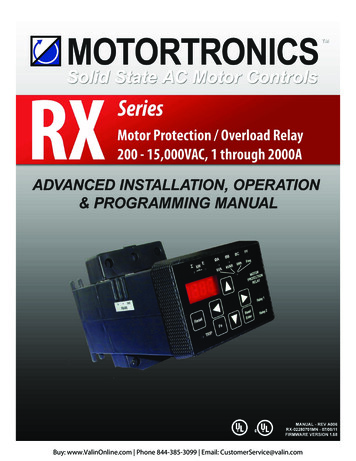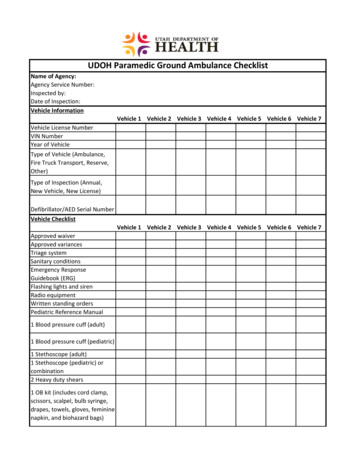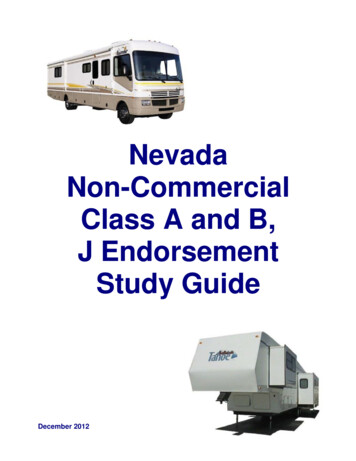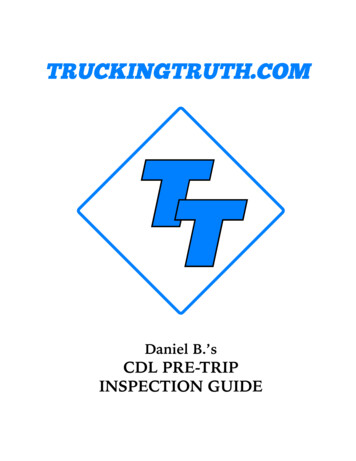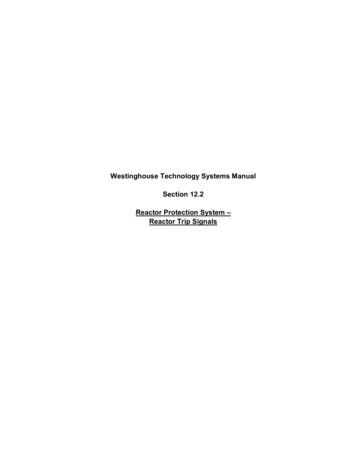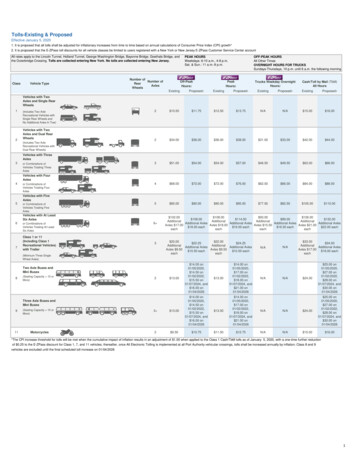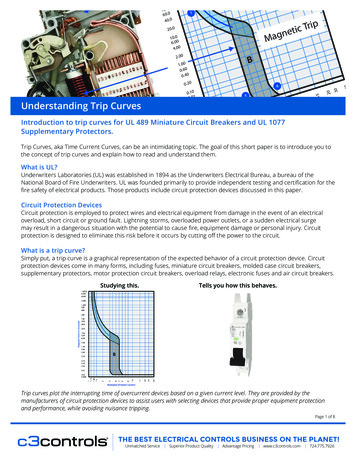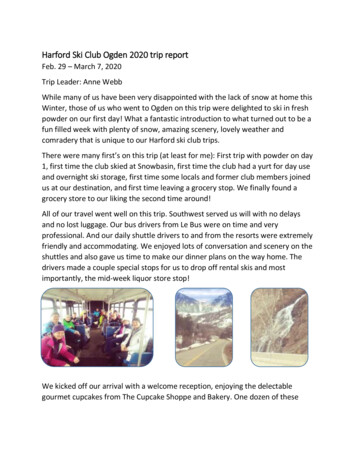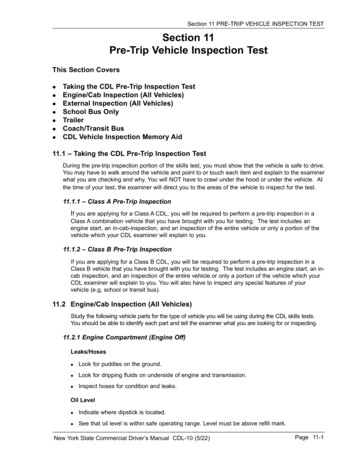
Transcription
Section 11 PRE-TRIP VEHICLE INSPECTION TESTSection 11Pre-Trip Vehicle Inspection TestThis Section CoverslllllllTaking the CDL Pre-Trip Inspection TestEngine/Cab Inspection (All Vehicles)External Inspection (All Vehicles)School Bus OnlyTrailerCoach/Transit BusCDL Vehicle Inspection Memory Aid11.1 – Taking the CDL Pre-Trip Inspection TestDuring the pre-trip inspection portion of the skills test, you must show that the vehicle is safe to drive.You may have to walk around the vehicle and point to or touch each item and explain to the examinerwhat you are checking and why. You will NOT have to crawl under the hood or under the vehicle. Atthe time of your test, the examiner will direct you to the areas of the vehicle to inspect for the test.11.1.1 – Class A Pre-Trip InspectionIf you are applying for a Class A CDL, you will be required to perform a pre-trip inspection in aClass A combination vehicle that you have brought with you for testing. The test includes anengine start, an in-cab-inspection, and an inspection of the entire vehicle or only a portion of thevehicle which your CDL examiner will explain to you.11.1.2 – Class B Pre-Trip InspectionIf you are applying for a Class B CDL, you will be required to perform a pre-trip inspection in aClass B vehicle that you have brought with you for testing. The test includes an engine start, an incab inspection, and an inspection of the entire vehicle or only a portion of the vehicle which yourCDL examiner will explain to you. You will also have to inspect any special features of yourvehicle (e.g, school or transit bus).11.2 Engine/Cab Inspection (All Vehicles)Study the following vehicle parts for the type of vehicle you will be using during the CDL skills tests.You should be able to identify each part and tell the examiner what you are looking for or inspecting.11.2.1 Engine Compartment (Engine Off)Leaks/HoseslLook for puddles on the ground.lLook for dripping fluids on underside of engine and transmission.lInspect hoses for condition and leaks.Oil LevellIndicate where dipstick is located.lSee that oil level is within safe operating range. Level must be above refill mark.New York State Commercial Driver’s Manual CDL-10 (5/22)Page 11-1
Section 11 PRE-TRIP VEHICLE INSPECTION TESTCoolant LevelInspect reservoir sight glass, orl(If engine is not hot), remove radiator cap and check for visible coolant level.lPower Steering FluidIndicate where power steering fluid dipstick is located.lCheck for adequate power steering fluid level. Level must be above refill mark.lEngine Compartment BeltslCheck the following belts for snugness (up to 3/4 inch play at center of belt), cracks, or frays:ØØØØPower steering belt.Water pump belt.Alternator belt.Air compressor belt.Note: If any of the components listed above are not belt driven, you must:lTell the examiner which component(s) are not belt driven.lMake sure component(s) are operating properly, are not damaged or leaking, and are mounted securely.Clutch/Gearshift (Safe Start)lDepress clutch.lPlace gearshift lever in neutral (or park, for automatic transmissions).lStart engine, then release clutch slowly.11.2.2 – Cab Check/Engine StartOil Pressure GaugelMake sure oil pressure gauge is working.lCheck that pressure gauge shows increasing or normal oil pressure or that the warning lightgoes off.lIf equipped, oil temperature gauge should begin a gradual rise to the normal operating range.Temperature GaugelMake sure the temperature gauge is working.lTemperature should begin to climb to the normal operating range or temperature light should be off.Air GaugelMake sure the air gauge is working properly.lBuild air pressure to governor cut-out, roughly 120-140 psi.Ammeter/VoltmeterlCheck that gauges show alternator and/or generator is charging or that warning light is off.Mirrors and WindshieldllMirrors should be clean and adjusted properly from the inside.Windshield should be clean with no illegal stickers, no obstructions, and no damage to the glass.Emergency EquipmentllCheck for spare electrical fuses.Check for three red reflective triangles, six fusees, or three liquid flares.Check for a properly charged and rated fire extinguisher.Note: If the vehicle is not equipped with electrical fuses, you must mention this to the examiner.lPage 11-2New York State Commercial Driver’s Manual CDL-10 (5/22)
Section 11 PRE-TRIP VEHICLE INSPECTION TESTSteering PlaylNon-power steering: Check for excessive play by turning steering wheel back and forth. Playshould not exceed 10 degrees (or about two inches on a 20-inch wheel).lPower steering: With the engine running, check for excessive play by turning the steering wheelback and forth. Play should not exceed 10 degrees (or about two inches on a 20-inch wheel)before front left wheel barely moves.Wipers/WashersllCheck that wiper arms and blades are secure, not damaged, and operate smoothly.If equipped, windshield washers must operate correctly.Lights/Reflectors/Reflector Tape Condition (Sides & Rear)lTest that dash indicators work when corresponding lights are turned on:ØØØØØlLeft turn signal.Right turn signal.Four-way emergency flashers.High beam headlight.Anti-lock Braking System (ABS) indicator.Check that all external lights and reflective equipment are clean and functional. Light andreflector checks include:ØØØØØØØØØClearance lights (red on rear, amber elsewhere).Headlights (high and low beams).Taillights.Backing lights.Turn signals.Four-way flashers.Brake lights.Red reflectors (on rear) and amber reflectors (elsewhere).Reflector tape conditionNote: Checks of brake, turn signal and four-way flasher functions must be done separately.HornlCheck that air horn and/or electric horn work.Heater/DefrosterlTest that the heater and defroster work.Parking Brake ChecklWith the parking brake engaged (trailer brakes released on combination vehicles), check thatthe parking brake will hold vehicle by gently trying to pull forward with parking brake on.lWith the parking brake released and the trailer parking brake engaged (combination vehiclesonly), check that the trailer parking brake will hold vehicle by gently trying to pull forward withthe trailer parking brake on.Hydraulic Brake ChecklPump the brake pedal three times, then hold it down for five seconds. The brake pedal shouldnot move (depress) during the five seconds.lIf equipped with a hydraulic brake reserve (back-up) system, with the key off, depress the brakepedal and listen for the sound of the reserve system electric motor.Check that the warning buzzer or light is off.lNew York State Commercial Driver’s Manual CDL-10 (5/22)Page 11-3
Section 11 PRE-TRIP VEHICLE INSPECTION TESTAir Brake Check (Air Brake Equipped Vehicles Only)lFailure to perform all three components of the air brake check correctly will result in anautomatic failure of the vehicle inspection test. Air brake safety devices vary. However, thisprocedure is designed to see that any safety device operates correctly as air pressure dropsfrom normal to a low air condition. For safety purposes, in areas where an incline is present, youwill use wheel chocks during the air brake check. The proper procedures for inspecting the airbrake system are as follows:Ø Static Check. Shut off the engine; chock your wheels, if necessary; release the tractorprotection valve and parking brake (push in); fully apply the foot brake and hold it for oneminute. Check the air gauge to see if the air pressure drops more than three pounds in oneminute (single vehicle) or four pounds in one minute (combination vehicle).Ø Check Low Air Pressure Warning Device. Turn the electrical power on and begin fanning offthe air pressure by rapidly applying and releasing the foot brake. Low air warning devices(buzzer, light, flag) should activate before air pressure drops below 60 psi.Ø Check Protection Valve and Spring Brakes Activation. Continue to fan off the air pressure. Atapproximately 40 psi on a tractor-trailer combination vehicle, the tractor protection valve andparking brake valve should close (pop out). On other combination vehicle types and singlevehicle types, the parking brake valve should close (pop out).Ø Check Air Compressor and Governed Cut-Off. Build the air pressure to governed cut-off(100-125 psi).Service Brake ChecklYou will be required to check the application of air or hydraulic service brakes. This procedureis designed to determine that the brakes are working correctly and that the vehicle does not pullto one side or the other.lPull forward at 5 mph, apply the service brake and stop. Check to see that the vehicle does notpull to either side and that it stops when brake is applied.Safety BeltlCheck that the safety belt is securely mounted, adjusts, latches properly, and is not ripped or frayed.11.3 – External Inspection (All Vehicles)11.3.1– SteeringSteering Box/HoseslCheck that the steering box is securely mounted and not leaking. Look for any missing nuts,bolts, and cotter keys.lCheck for power steering fluid leaks or damage to power steering hoses.Steering LinkagelSee that connecting links, arms, and rods from the steering box to the wheel are not worn orcracked.lCheck that joints and sockets are not worn or loose and that there are no missing nuts, bolts, orcotter keys.Page 11-4New York State Commercial Driver’s Manual CDL-10 (5/22)
Section 11 PRE-TRIP VEHICLE INSPECTION TEST11.3.2 – SuspensionSprings/Air/TorquelLook for missing, shifted, cracked, or broken leaf springs.lLook for broken or distorted coil springs.lIf vehicle is equipped with torsion bars, torque arms, or other types of suspension components,check that they are not damaged and are mounted securely.lAir ride suspension should be checked for damage and leaks.MountslLook for cracked or broken spring hangers; missing or damaged bushings; and broken, loose,or missing bolts, u-bolts or other axle mounting parts. (The mounts should be checked at eachpoint where they are secured to the vehicle frame and axle[s]).Shock AbsorberslSee that shock absorbers are secure and that there are no leaks.Note: Be prepared to perform the same suspension components inspection on every axle (powerunit and trailer, if equipped).11.3.3 – BrakesSlack Adjusters and PushrodslLook for broken, loose, or missing parts.lFor manual slack adjusters, the brake pushrod should not move more than one inch (with thebrakes released) when pulled by hand.Brake ChamberslSee that brake chambers are not leaking, cracked, or dented and are mounted securely.Brake Hoses/LineslLook for cracked, worn, or leaking hoses, lines, and couplings.Drum BrakelCheck for cracks, dents, or holes. Also check for loose or missing bolts.lCheck for contaminants, such as debris or oil/grease.lBrake linings (where visible) should not be worn dangerously thin.Brake LiningslOn some brake drums, there are openings where the brake linings can be seen from outside thedrum. For this type of drum, check that a visible amount of brake lining is showing.Note: Be prepared to perform the same brake components inspection on every axle (power unitand trailer, if equipped).11.3.4 – WheelsRimslCheck for damaged or bent rims. Rims cannot have welding repairs.New York State Commercial Driver’s Manual CDL-10 (5/22)Page 11-5
Section 11 PRE-TRIP VEHICLE INSPECTION TESTTireslThe following items must be inspected on every tire:Ø Tread depth: Check for minimum tread depth (4/32 on steering axle tires, 2/32 on all other tires).Ø Tire condition: Check that tread is evenly worn and look for cuts or other damage to tread orsidewalls. Also, make sure that valve caps and stems are not missing, broken, or damaged.Ø Tire inflation: Check for proper inflation by using a tire gauge. Note: You will not get credit ifyou simply kick the tires to check for proper inflation.Hub Oil Seals/Axle SealslSee that hub oil/grease seals and axle seals are not leaking and, if wheel has a sight glass, oillevel is adequate.Lug NutslCheck that all lug nuts are present, free of cracks and distortions, and show no signs oflooseness such as rust trails or shiny threads.lMake sure all bolt holes are not cracked or distorted.Spacers or Budd SpacinglIf equipped, check that spacers are not bent, damaged, or rusted through.lSpacers should be evenly centered, with the dual wheels and tires evenly separated.Note: Be prepared to perform the same wheel inspection on every axle (power unit and trailer, ifequipped).11.3.5 – Side of VehicleDoor(s)/Mirror(s)lCheck that door(s) are not damaged and that they open and close properly from the outside.lHinges should be secure with seals intact.lCheck that mirror(s) and mirror brackets are not damaged and are mounted securely with noloose fittings.Fuel TanklCheck that tank(s) are secure, cap(s) are tight, and that there are no leaks from tank(s) or lines.Battery/BoxlWherever located, see that battery(s) are secure, connections are tight, and cell caps arepresent.lBattery connections should not show signs of excessive corrosion.lBattery box and cover or door must be secure.Drive ShaftlSee that drive shaft is not bent or cracked.lCouplings should be secure and free of foreign objects.Page 11-6New York State Commercial Driver’s Manual CDL-10 (5/22)
Section 11 PRE-TRIP VEHICLE INSPECTION TESTExhaust SystemlCheck system for damage and signs of leaks such as rust or carbon soot.lSystem should be connected tightly and mounted securely.FramelLook for cracks, broken welds, holes or other damage to the longitudinal frame members, crossmembers, box, and floor.11.3.6 – Rear of VehicleSplash GuardslIf equipped, check that splash guards or mud flaps are not damaged and are mounted securely.Doors/Ties/LiftslCheck that doors and hinges are not damaged and that they open, close, and latch properlyfrom the outside, if equipped.lTies, straps, chains, and binders must also be secure.lIf equipped with a cargo lift, look for leaking, damaged or missing parts and explain how it shouldbe checked for correct operation.lLift must be fully retracted and latched securely.11.3.7 – Tractor/CouplingAir/Electric LineslListen for air leaks. Check that air hoses and electrical lines are not cut, chafed, spliced, or worn(steel braid should not show through).lMake sure air and electrical lines are not tangled, pinched, or dragging against tractor parts.CatwalklCheck that the catwalk is solid, clear of objects, and securely bolted to tractor frame.Mounting BoltslLook for loose or missing mounting brackets, clamps, bolts, or nuts. Both the fifth wheel and theslide mounting must be solidly attached.lOn other types of coupling systems (i.e., ball hitch, pintle hook, etc.), inspect all couplingcomponents and mounting brackets for missing or broken parts.Hitch Release LeverlCheck to see that the hitch release lever is in place and is secure.Locking JawslLook into fifth wheel gap and check that locking jaws are fully closed around the kingpin.lOn other types of coupling systems (i.e., ball hitch, pintle hook, etc.), inspect the lockingmechanism for missing or broken parts and make sure it is locked securely. If present, safetycables or chains must be secure and free of kinks and excessive slack.Fifth Wheel Skid PlatelCheck for proper lubrication and that fifth wheel skid plate is securely mounted to the platform,and that all bolts and pins are secure and not missing.New York State Commercial Driver’s Manual CDL-10 (5/22)Page 11-7
Section 11 PRE-TRIP VEHICLE INSPECTION TESTPlatform (Fifth Wheel)lCheck for cracks or breaks in the platform structure that supports the fifth wheel skid plate.Release Arm (Fifth Wheel)lIf equipped, make sure the release arm is in the engaged position and the safety latch is in place.Kingpin/Apron/GaplCheck that the kingpin is not bent.lMake sure the visible part of the apron is not bent, cracked, or broken.lCheck that the trailer is laying flat on the fifth wheel skid plate (no gap).Locking Pins (Fifth Wheel)lIf equipped, look for loose or missing pins in the slide mechanism of the sliding fifth wheel. If airpowered, check for leaks.lMake sure locking pins are fully engaged.lCheck that the fifth wheel is positioned properly so that the tractor frame will clear the landinggear during turns.Sliding PintlelCheck that the sliding pintle is secured with no loose or missing nuts or bolts, and cotter pin isin place.Tongue or Draw-barlCheck that the tongue/draw-bar is not bent or twisted, and check for broken welds and stress cracks.lCheck that the tongue/draw-bar is not worn excessively.Tongue Storage arealCheck that the storage area is solid and secured to the tongue.lCheck that cargo in the storage area (i.e., chains, binders, etc.) is secure.11.4 – School Bus OnlyEmergency EquipmentlIn addition to checking for spare electrical fuses (if equipped), three red reflective triangles, anda properly charged and rated fire extinguisher, school bus drivers must also inspect for thepresence of a nine-item first-aid kit.Lighting IndicatorslIn addition to checking the lighting indicators listed in Section 10.2 of this manual, school busdrivers must also check the following lighting indicators (internal panel lights):Ø Alternately flashing amber lights indicator, if equipped.Ø Alternately flashing red lights indicator.Ø Strobe light indicator, if equipped.Page 11-8New York State Commercial Driver’s Manual CDL-10 (5/22)
Section 11 PRE-TRIP VEHICLE INSPECTION TESTLights/ReflectorslIn addition to checking the lights and reflective devices listed in Section 10.2 of this manual,school bus drivers must also check the following (external) lights and reflectors:ØØØØStrobe light, if equipped.Stop arm light, if equipped.Alternately flashing amber lights, if equipped.Alternately flashing red lights.Student MirrorslIn addition to checking the external mirrors, school bus drivers must also check the internal andexternal mirrors used for observing students:Ø Check for proper adjustment.Ø Check that all internal and external mirrors and mirror brackets are not damaged and aremounted securely with no loose fittings.Ø Check that visibility is not impaired due to dirty mirrors.Stop ArmlIf equipped, check the stop arm to see that it is mounted securely to the frame of the vehicle.Also, check for loose fittings and damage.Passenger Entry/LiftlCheck that the entry door is not damaged, operates smoothly, and closes securely from the inside.lHand rails are secure and the step light is working, if equipped.lThe entry steps must be clear with the treads not loose or worn excessively.lIf equipped with a handicap lift, look for leaking, damaged, or missing parts and explain how liftshould be checked for correct operation. Lift must be fully retracted and latched securely.Emergency ExitlMake sure that that all emergency exits are not damaged, operate smoothly, and close securelyfrom the inside.lCheck that any emergency exit warning devices are working.SeatinglLook for broken seat frames and check that seat frames are firmly attached to the floor.lCheck that seat cushions are attached securely to the seat frames.11.5 – Trailer11.5.1 – Trailer FrontAir/Electrical ConnectionslCheck that trailer air connectors are sealed and in good condition.lMake sure glad hands are locked in place, free of damage or air leaks.lMake sure the trailer electrical plug is firmly seated and locked in place.New York State Commercial Driver’s Manual CDL-10 (5/22)Page 11-9
Section 11 PRE-TRIP VEHICLE INSPECTION TESTHeader BoardlIf equipped, check the header board to see that it is secure, free of damage, and strong enoughto contain cargo.lIf equipped, the canvas or tarp carrier must be mounted and fastened securely.lOn enclosed trailers, check the front area for signs of damage such as cracks, bulges, or holes.11.5.2 – Side of TrailerLanding GearlCheck that the landing gear is fully raised, has no missing parts, crank handle is secure, and thesupport frame is not damaged.lIf power operated, check for air or hydraulic leaks.Doors/Ties/LiftslIf equipped, check that doors are not damaged. Check that doors open, close, and latch properlyfrom the outside.lCheck that ties, straps, chains, and binders are secure.lIf equipped with a cargo lift, look for leaking, damaged or missing parts and explain how it shouldbe checked for correct operation.lLift should be fully retracted and latched securely.FramelLook for cracks, broken welds, holes or other damage to the frame, cross members, box, and floor.Tandem Release Arm/Locking PinslIf equipped, make sure the locking pins are locked in place and release arm is secured.11.5.3 – Remainder of TrailerRemainder of TrailerlPlease refer to Section 11.2 of this manual for detailed inspection procedures regarding thefollowing components:ØØØØØWheels.Suspension system.Brakes.Doors/ties/lift.Splash guards.11.6 – Coach/Transit Bus11.6.1 – Passenger ItemsPassenger Entry/LiftlllCheck that entry doors operate smoothly and close securely from the inside.Check that hand rails are secure and, if equipped, that the step light(s) are working.Check that the entry steps are clear, with the treads not loose or worn excessively.lIf equipped with a handicap lift, look for any leaking, damaged or missing part, and explain howit should be checked for correct operation.lLift should be fully retracted and latched securely.Page 11-10New York State Commercial Driver’s Manual CDL-10 (5/22)
Section 11 PRE-TRIP VEHICLE INSPECTION TESTEmergency ExitslMake sure that all emergency exits are not damaged, operate smoothly, and close securely fromthe inside.lCheck that any emergency exit warning devices are working.Passenger SeatinglLook for broken seat frames and check that seat frames are firmly attached to the floor.lCheck that seat cushions are attached securely to the seat frames.11.6.2 – Entry/ ExitDoors/MirrorslCheck that entry/exit doors are not damaged and operate smoothly from the outside. Hingesshould be secure with seals intact.lMake sure that the passenger exit mirrors and all external mirrors and mirror brackets are notdamaged and are mounted securely with no loose fittings.11.6.3 – External Inspection of Coach/ Transit BusLevel/Air LeakslSee that the vehicle is sitting level (front and rear), and if air-equipped, check for audible airleaks from the suspension system.Fuel Tank(s)lSee that fuel tank(s) are secure with no leaks from tank(s) or lines.Baggage CompartmentslCheck that baggage and all other exterior compartment doors are not damaged, operateproperly, and latch securely.Battery/BoxlllWherever located, see that battery(s) are secure, connections are tight, and cell caps are present.Battery connections should not show signs of excessive corrosion.Check that battery box and cover or door is not damaged and is secure.11.6.4 – Remainder of Coach/ Transit BusRemainder of VehiclelPlease refer to Section 11.2 and 11.3 of this manual for detailed inspection procedures for theremainder of the vehicle.New York State Commercial Driver’s Manual CDL-10 (5/22)Page 11-11
Section 11 PRE-TRIP VEHICLE INSPECTION TEST11.7 – CDL Vehicle Inspection Memory AidCombination VehiclesSteering Axlel Suspensionl Brakesl TiresDriver DoorFuel AreaStraight Truck or BusFront of Vehicle, Lights/Reflectors,Engine Compartment & SteeringComponentsEngine StartProceduresUnder Vehiclel Drive Shaftl Exhaustl FrameFront of Vehicle, Lights/Reflectors,Engine Compartment & SteeringSteering Axle Componentsl Suspensionl Brakesl TiresDriver DoorFuel AreaUnder Vehiclel Drive Shaftl Exhaustl FrameDrive Axle(s)l Suspensionl Brakesl TiresPassenger items(Buses Only)Coupling Devicesl Truckl TrailerSchool Bus Items(School Buses Only)Rear ofTruck/Tractor &Lights/ReflectorsSide of Vehicle &Lights/ReflectorsTrailer Componentsl Front, Side, Lights& Reflectorsl Framel Landing Gearl Tandem ReleaseTrailer Axle(s)l Suspensionl Brakesl TiresPage 11-12Engine StartProceduresDrive Axle(s)l Suspensionl Brakesl TiresRear of Vehicle andLights/ReflectorsRear of Trailer andLights/ReflectorsNew York State Commercial Driver’s Manual CDL-10 (5/22)
Section 12 BASIC VEHICLE CONTROL SKILLS TESTSection 12Basic Vehicle Control Skills TestThis Section CoversllSkills Test ScoringSkills Test ExercisesYour basic control skills could be tested using one or more of the following exercises off-road orsomewhere on the street during the road test:llllllStraight line backing.Offset back/rightOffset back/leftParallel park (driver side).Parallel park (conventional).Alley dock.These exercises are shown in Figures 12-1 through 12-6.12.1 ScoringllllCrossing Boundaries (Encroachments)Pull-upsOutside Vehicle Observations (Looks)Final PositionCrossing Boundaries (Encroachments) – The examiner will score the number of times you touch orcross over an exercise boundary line with any portion of your vehicle. Each encroachment will countas an error.Pull-ups – When a driver stops and reverses direction to get a better position, it is scored as a “pullup”. Stopping without changing direction does not count as a pull-up. You will not be penalized for initialpull-ups. However, an excessive number of pull-ups will count as errors.Outside Vehicle Observations (Looks) – You may be permitted to safely stop and exit the vehicle tocheck the external position of the vehicle (look). When doing so, you must place the vehicle in neutraland set the parking brake(s). Then, when exiting the vehicle, you must do so safely by facing thevehicle and maintaining three points of contact with the vehicle at all times (when exiting a bus,maintain a firm grasp on the handrail at all times). If you do not safely secure the vehicle or safely exitthe vehicle it may result in an automatic failure of the basic vehicle control skills test. The maximumnumber of times that you may look to check the position of your vehicle is two (2) except for the StraightLine Backing exercise, which allows one look. Each time you open the door, move from a seatedposition where in physical control of the vehicle or, on a bus, walk to the back of the bus to get a betterview, it is scored as a “look”.Final Position – It is important that you finish each exercise exactly as the examiner has instructed you.If you do not maneuver the vehicle into its final position as described by the examiner, you will bepenalized and could fail the basic skills test.New York State Commercial Driver’s Manual CDL-10 (5/22)Page 12-1
Section 12 BASIC VEHICLE CONTROL SKILLS TEST12.2 Exercises12.2.1 – Straight Line BackingYou may be asked to back your vehicle in a straight line on a street or between two rows of coneswithout touching or crossing over the exercise boundaries. See Figure 12.1.Figure 12.112.2.2 – Offset Back/RightYou may be asked to back into a space that is to the right rear of your vehicle. You will drive straightforward and back your vehicle into that space without striking the side or rear boundaries markedby cones. You must place your vehicle completely into the space. See Figure 12.2.Figure 12.212.2.3 – Offset Back/LeftYou may be asked to back into a space that is to the left rear of your vehicle. You will drive straightforward and back your vehicle into that space without striking the side or rear boundaries markedby cones. You must place your vehicle completely into the space. See Figure 12.3.Figure 12.312.2.4 – Parallel Park (Driver Side)You may be asked to park in a parallel parking space that is on your left. You are to drive past theparking space and back into it bringing the rear of your vehicle as close as possible to the rear ofthe space without crossing side or rear boundaries marked by cones. You are required to get yourvehicle completely into the space. See Figure 12.4.Figure 12.4Page 12-2New York State Commercial Driver’s Manual CDL-10 (5/22)
Section 12 BASIC VEHICLE CONTROL SKILLS TEST12.2.5 – Parallel Park (Conventional)You may be asked to park in a parallel parking space that is on your right. You are to drive past theparking space and back into it bringing the rear of your vehicle as close as possible to the rear ofthe space without crossing side or rear boundaries marked by cones. You are required to get yourvehicle completely into the space. See Figure 12.5.Figure 12.512.2.6 – Alley DockYou may be asked to sight-side back your vehicle into an alley, bringing the rear of your vehicle asclose as possible to the rear of the alley without going beyond the exercise boundary marked by aline or row of cones. You are required to get your vehicle completely into the space with your entirevehicle straight with the alley. See Figure 12.6.Figure 12.6New York State Commercial Driver’s Manual CDL-10 (5/22)Page 12-3
Section 13 ON-ROAD DRIVING TESTSection 13On-Road Driving TestThis Section CoversllSpecific Driving ManeuversYour Overall Performance and General Driving BehaviorYou will drive over a test route that has a variety of traffic situations. At all times during the test, youmust drive in a safe and responsible manner.During the driving test you must:lllWear your safety belt.Obey all traffic signs, signals, and laws.Complete the test without an accident or moving violation.During the driving test, the examiner will be scoring you on specific driving maneuvers as well ason your general driving behavior. You will follow the directions of the examiner. Directions will begiven to you so you will have plenty of time to do what the examiner has asked. You will not beasked to drive in an unsafe manner.If your test route does not have certain traffic situations, you may be asked to simulate a traffic situation.You will do this by telling the examiner what you are or would be doing if you were in that traffic situation.13.1 – Specific Driving Maneuvers13.1.1 – TurnsYou have been asked to make a turn:lCheck traffic in all directions.lUse turn signals and safely get into the lane needed for the turn.As you approach the turn:lUse turn signals to warn others of your turn.lSlow down smoothly, change gears as needed to keep power, but do not coast unsafely. Unsafecoasting occurs when your vehicle is out of gear (
Page 11-4 New York State Commercial Driver's Manual CDL-10 (5/22) 11.3.2 - Suspension. Springs/Air/Torque. l. Look for missing, shifted, cracked, or broken leaf springs. l. Look for broken or distorted coil springs. l. If vehicle is equipped with torsion bars, torque arms, or other types of suspension components,
